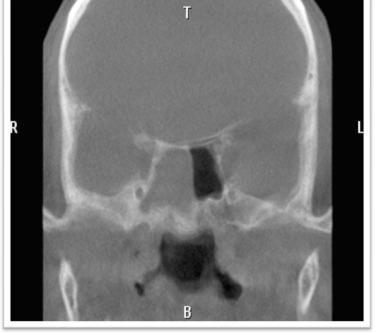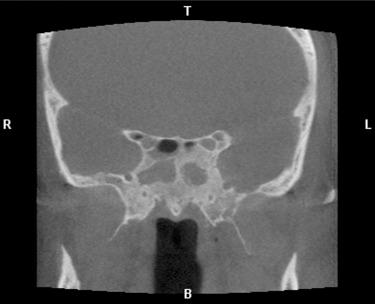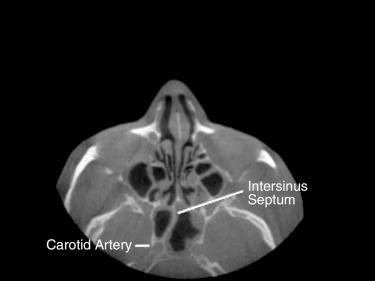Physical Address
304 North Cardinal St.
Dorchester Center, MA 02124
Endoscopic sphenoidotomy has become the most common surgical approach for management of inflammatory and neoplastic diseases of the sphenoid sinus largely due to its excellent outcomes and low morbidity.
Long-term outcomes of endoscopic sphenoidotomy in the context of isolated sphenoid sinus disease (ISSD) have demonstrated patency rates of greater than 90% at a follow-up of up to 4 years.
However, chronic rhinosinusitis with sphenoid involvement is more challenging to treat. Although it is typically the least common sinus involved, additional surgery is necessary in 34% to 65% of revision cases due to persistent/recurrent disease and stenosis.
Given this, it is important to consider potential causes for sphenoidotomy failure. The most commonly cited reasons include
circumferentially denuded bone
inadequate size
bony osteitis
While circumferentially denuded bone and inadequate size can often be managed with more mucosal-sparing techniques and wider sphenoid antrostomies, the issue of underlying bony osteitis may require modifications to the traditional endoscopic sphenoid sinus procedure.
Hierarchy of surgical management of chronic sphenoid sinusitis :
Standard sphenoidotomy
Sphenoid “drill-out” (wide removal of bilateral sphenoid faces and intersinus septum)
Radical sphenoidectomy or sphenoid marsupialization
Sphenoid drill-out is associated with low nasal morbidity. One study demonstrated a 100% patency rate in nine patients at a mean-follow-up of 17.1 months.
This chapter aims to highlight the techniques of extended sphenoid sinus antrostomy and radical sphenoidectomy as alternatives for the management of severe chronic sphenoiditis with associated bony inflammation.
The use of a modified short/mini-pedicled nasal septal flap will also be highlighted as an adjunctive procedure to cover areas of denuded bone. This technique has previously been described through a case series of nine patients and resulted in 100% patency at a mean postoperative follow-up at 8.4 months. The most common indication for its use was fungal rhinosinusitis.
The steps of an extended sphenoid sinus antrostomy may also serve as the foundation for endoscopic transsphenoidal approaches for management of sphenoid sinus and skull base tumors.
Most of the relevant anatomy of the sphenoid sinus is reviewed in Chapter 8 .
For the procedures described in this chapter, it is important to understand the location of the septal branch of the nasoseptal artery.
The nasoseptal artery is the main blood supply for the pedicled nasoseptal flap described by Hadad et al.
Arising as a terminal branch of the sphenopalatine artery, it commonly takes a horizontal course along the sphenoid face, midway between the natural sphenoid ostium and the arch of the choana before branching and supplying the septal mucosa.
The location of this artery must be considered because inferior widening of the sphenoid antrostomy may inadvertently compromise and sacrifice the main blood supply for the nasoseptal flap.
Extended sphenoid sinus antrostomy or radical sphenoidectomy may be performed in isolation or as part of a complete functional endoscopic sinus surgery procedure.
The presence of bony osteitis can be appreciated when preoperative computed tomography (CT) scans are reviewed.
As with other elements of endoscopic sinus surgery, it is imperative to allow adequate time for mucosal decongestion.
This decongestion can be accomplished with pledgets soaked in either topical oxymetazoline or topical epinephrine at a concentration of 1:1000.
Topical pledgets should be placed medial to the superior turbinate and in the sphenoethmoidal recess to enhance identification of the sphenoid ostium.
As in a standard endoscopic sphenoidotomy procedure, preoperative CT imaging is useful for recognizing the presence of Onodi (sphenoethmoidal) cells and a dehiscent carotid artery or optic nerve.
There are two variations of the extended sphenoid sinus antrostomy procedure.
The first is a modification to the traditional unilateral endoscopic sphenoidotomy.
This procedure is often indicated for bony osteitis secondary to an isolated sphenoid mycetoma.
In Fig. 16.1 , note the extensive bony thickening in the right sphenoid sinus compared to the left side.

The second variation of the extended sphenoid sinus antrostomy procedure involves the creation of a single combined sphenoid sinus by joining the left and right sides together (sphenoid “drill-out”).
This procedure is most often indicated for bilateral chronic sphenoiditis with extensive bony thickening that has failed previous endoscopic attempts (i.e., the sinus is deemed to be nonfunctional).
In Fig. 16.2 , note the extensive bony osteitis in both sphenoid sinuses.

For this procedure, the sphenoid intersinus septum needs to be removed; thus, it is important to note its location relative to the carotid artery.
This is best appreciated on an axial CT image.
Note the intersinus septum curving toward the right carotid artery in Fig. 16.3 .

Radical sphenoidectomy ensures total marsupialization of the sphenoid cavity.
It eliminates the reliance of ciliary action of the mucosa to carry mucus up and out of the sinus cavity and reduces the impact of postoperative cicatrization.
It can perform unilateral or bilateral sphenoid marsupialization.
0-degree and 30-degree endoscopes
J-curette
Straight through-cutter
Upbiting through-cutter
Rotating sphenoid Hajak punch or 2-mm and 4-mm Kerrison rongeurs
Straight-microdébrider
Straight suction irrigation drill
Freer elevator
15-blade and round knife on extended handles
The sphenoid sinus ostium is often at the same vertical level as the roof of the maxillary sinus (a good landmark for the relative height of entry into the sphenoid sinus).
If present, the superior turbinate is the best landmark for the sphenoid ostium and is often just posterior-medial to the superior turbinate.
If the sphenoid ostium cannot be easily identified because of previous surgery or inflammatory disease, the use of image guidance may help identify the floor and roof of the sphenoid sinus before surgical entry.
The sphenoid rostrum will need to be removed if both sides of the sphenoid sinus will be joined together; the rostrum resembles the keel of a ship.
If required, the sphenoid intersinus septum should be removed precisely either with straight through-cutting instruments or with an irrigating diamond drill bur.
The majority of the endoscopic dissection can be accomplished with a 0-degree endoscope.
The 30-degree endoscope is useful for inspecting the floor, roof, and lateral recesses of the sphenoid sinus to make sure that all disease has been evacuated.
Repeated saline irrigations of the sinus are imperative to ensure that all disease has been removed.
When landmarks such as the superior turbinate are missing from previous surgery, it is imperative to not venture too high superiorly, because the skull base slopes from anterior to posterior toward the sphenoid sinus.
If you open the sphenoid sinus inferiorly before a pedicled nasoseptal flap is raised, the blood supply to the flap may be inadvertently divided.
The sphenoid intersinus septum often curves toward the carotid canal in the sphenoid sinus. Blunt manipulation of the septum may lead to unpredictable bony breaks near the carotid artery.
If a microdébrider is used to remove polyps near the sphenoid ostium, it is important not to engage the microdébrider within the sphenoid sinus itself.
A standard sphenoidotomy can be performed as long as it is not widened inferiorly.
Become a Clinical Tree membership for Full access and enjoy Unlimited articles
If you are a member. Log in here